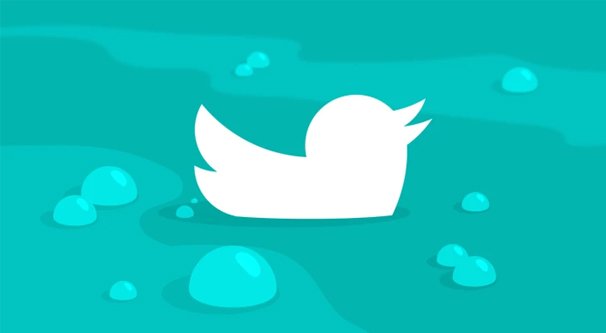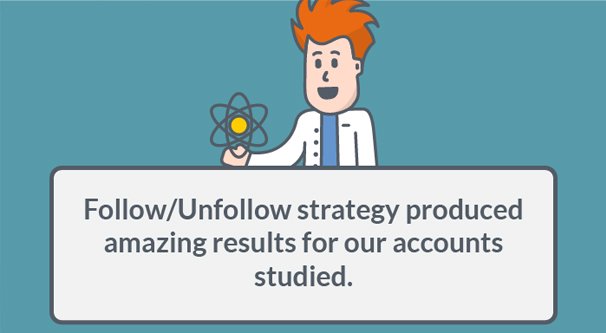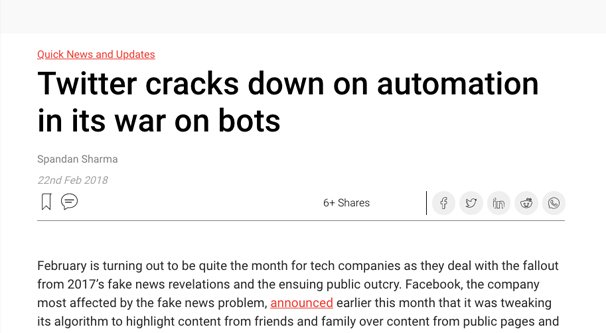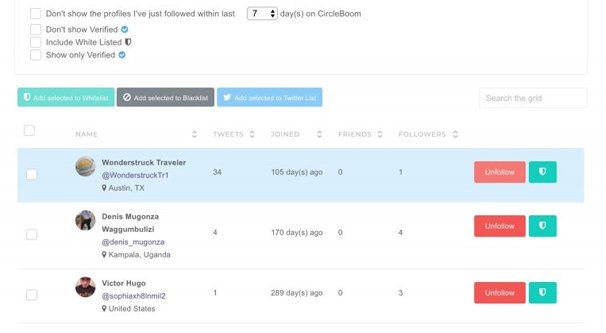If you’re a newcomer to social media and in particular social media automation, you may wonder why there’s enough material to write an entire article about the concept of unfollowing someone. It seems pretty simple, right? You don’t like what you see a person posting in your feed, so you unfollow them. That’s it, end of story.
There’s a lot more depth to it, unfortunately, and some of that depth is only visible once you’re aware of the marketing techniques that surround these actions. So let’s talk about it!
Follow and Unfollow
The follow/unfollow technique has been around for a long time, mostly centered around Twitter and Instagram, though it had its day in the sun on pretty much every social network. It’s also known as follower churn.
So what is it? Basically, it abuses the etiquette of a social network, or what etiquette there used to be. Years ago, it was good practice that when someone followed you, you followed them back. At the very least, you would click through to their profile to see what they’re all about and make a decision about whether or not you wanted to follow them. Many people simply clicked the follow button and pruned their feed from there.
The trouble comes when certain people decide to abuse this etiquette. Imagine a world where everyone follows back anyone they follow. The social network would look a lot like Facebook, which is built around these reciprocal friendships rather than one-sided follows. Now imagine that I come through and follow 1,000 different people.
This means I get 1,000 people following me back. Well, more or less. Maybe a few of those people don’t log in actively, and a few of them don’t partake in the general etiquette of the site. Maybe I get 900 follows out of my actions.
Now I go through and unfollow all 1,000 of those people. I’m left with 900 more follows than I had before, and all of those people no longer have me as a follower. They were tricked into following me.
Social networks don’t like this kind of abuse. Twitter especially has had a lot of problems with this kind of follower churn. The trouble is, it’s a difficult problem to solve.
What can you do? If you put a limit on the number of people you can follow in a day, people creating new accounts may run into problems. If you put a limit on the people reciprocal follows, then you have issues with building relationships. If you put a restriction on following and then unfollowing the same person in a short period of time, people become afraid to fix mistakes. What if you follow someone because of a funny tweet, then find out they’re racist, but then you get suspended for unfollowing them too quickly?
Twitter’s solution to stop follower churn is to monitor the rate at which people unfollow other people. Among other actions, Twitter just keeps track of how frequently you’re unfollowing people and how soon after following them you’re removing them. A few quick churns aren’t bad, it’s natural to make a few mistakes and want to undo them. It’s when you have hundreds or thousands of accounts in churn that you run into real issues.
Twitter does have other limits, by the way. They do not limit the number of accounts you can follow as a whole, but they limit you to only following up to 400 accounts per day. The exception to this is if your account is verified and they want you to grow faster, so your limit is bumped up to 1,000.
Additionally, you can only follow up to 5,000 accounts until you’ve reached a certain number of followers in return. There’s a specific ratio that Twitter does not state publicly; you need to have a sufficiently large number of followers so you can follow more people. This is a bot prevention measure as well; otherwise bot sellers would just create accounts and use them to follow people in the hundreds of thousands.
Does the Follow/Unfollow Method Work?
So here’s the thing. If the method doesn’t work, why would Twitter put so much effort into fighting it?
The follower churn method only works as long as users are willing to look at the accounts that follow them and consider following them in return. The days of automatic follow-backs are pretty well and gone, but some people still follow back, so all is not completely lost.
Last year, AgoraPulse performed a study on both Twitter and Instagram about the follow/unfollow strategy. They wondered: does it work? Rather than just testing follows, however, they also tested to see how engagement fares after the fact.
The hypothesis is simple. Follow/unfollow would work to gather new followers, but because those are likely to be the least relevant followers from a given audience, engagement would likely go down. Was that true?
You can read the study yourself here. The answer, though, is surprising. In fact, the follow/unfollow method works and works surprisingly well. Many of the accounts they followed in the experiment did indeed follow them back, and what’s more, many of them continued to engage. Engagement went up on all of the accounts they monitored.
Now, there are a few confounding variables here that mean their experiment might work better than you trying to mimic the technique.
- AgoraPulse is a well-known name in the industry, and thus their follow is worth quite a bit, and they’re trusted enough to earn that follow in return.
- They carefully chose the hashtags they were monitoring to follow users using them, rather than picking a scattershot selection or following people randomly, which would put a damper on the relevance of the audience they develop.
- They are operating at relatively small volumes, as far as the scale of Twitter is concerned. We’re talking low thousands of people, not tens or hundreds of thousands as some accounts try to achieve.
- Raw numbers of engagement went up, but the engagement RATE was about the same. This jives with the idea that they carefully targeted their potential audience, rather than letting automation handle it for them.
So what’s the real difference between what AgoraPulse did in this study and what low quality accounts do? Other than the inherent quality of their content, AgoraPulse went for quality over quantity. They may have been using a semi-banned technique to accomplish their goals, but they were still aiming for those goals, rather than just aiming for the biggest number possible as quickly as possible.
The Trouble with Automation
One of the growth feature often offered by many of the Twitter growth platforms and apps is that they can handle growth for you. You tell them what you want as your growth goals, and they go “okay” and buckle down to do it.
The automation these platforms typically use is simply the follow/unfollow method. You tell them what you want in the form of keywords, and they go out looking in the keyword feeds for those keywords. They find accounts you don’t already follow and that don’t follow you, and they follow them on your account. They then wait a while – sometimes 24 hours, sometimes a week, sometimes somewhere in between – and then unfollow the other account.
Some of these growth platforms have skipped the unfollow altogether. Since the unfollow is the dangerous part, if they skip it and leave it to you to prune or ignore you feed as you so desire, they an grow faster. Others will put rate limits on the unfollows, and some will force you to do it manually. They simply give you a list of people who you follow but who do not follow you back, and ask if you want to unfollow them.
This is where the Update portion of the blog post title comes in, by the way. Recently, Twitter put out a notice asking any app that automatically handles unfollows to knock it off.
Some such tools, in response, simply shut their doors. If the follow/unfollow method was the only thing they did, this change to Twitter’s handling of the API means they’re out of business. Others are more robust platforms that offer more than just unfollows, and those platforms – these for example – simply adapt. The new normal is to give a user a list of people who don’t follow them back and ask them to decide what to do, clicking buttons manually to handle the unfollows where necessary.
Why Unfollow at All?
So here’s a question for you: why unfollow those accounts at all? I’ve seen a few competing strategies.
- Follow them and if they don’t follow you back within X amount of time, unfollow them.
- Follow them and then unfollow them later regardless of whether they followed you back.
- Follow them and just hope they follow you back. Don’t unfollow at all.
Now, if you’re operating on spam rules where volume is better than quality, of course you’re going to want to unfollow as aggressively as possible. Otherwise you’ll run into the ratio limit I mentioned up above. Sooner or later you’ll need to unfollow people to make space for more follows.
My question is, why bother with the spam method?
AgoraPulse proved that a focused attempt at the follow/unfollow method, emphasizing quality over quantity, works quite well. They unfollowed people, but why should they bother? The unfollow is the dangerous part of the equation. You only need to unfollow people once you near the ratio where you’re cut off from following more people.
If you do it properly, you’re not going to end up full of spam. Since you’re using hashtag feeds to find these users to follow, you know they’re active because they’re active in the chronological feed. The only thing you need to worry about is the ratio, and you can just slowly prune out people over the course of weeks or months rather than all at once with some automatic tool.
Now, once you follow a few hundred or a few thousand people, you’ll notice that your feed is getting pretty cluttered. You have to rely on increasingly sorted algorithmic feeds like Facebook rather than Twitter’s native chronological feeds, and even then you’re going to miss a lot of content. This is where alternative displays come in.
Why not just use lists? When your feed gets too full of people you don’t really care about, you can build a few private lists full of the people whose content you really want to see. Then just use a platform like Tweetdeck to view your list feeds instead of your primary feed, and you should have no trouble keeping up with the gold in your feed. Plus, you’ll have a broader grasp of your audience and of your industry when you monitor your standard feed as well.
Personally, I’ve always thought the follow/unfollow method was a little dumb and a little exploitative, but it clearly works. If you go about it slowly, carefully, and above all, manually, you won’t have the same issues you run into with automation spam.
Of course, you can use whatever marketing techniques you want to use. IF an automated blast of follow/unfollow with just the right level of action to avoid the filters is what you want to do, who am I to stop you? In fact, let me know how it turns out. I want to know what kind of actions people are pulling off or getting banned for trying.









